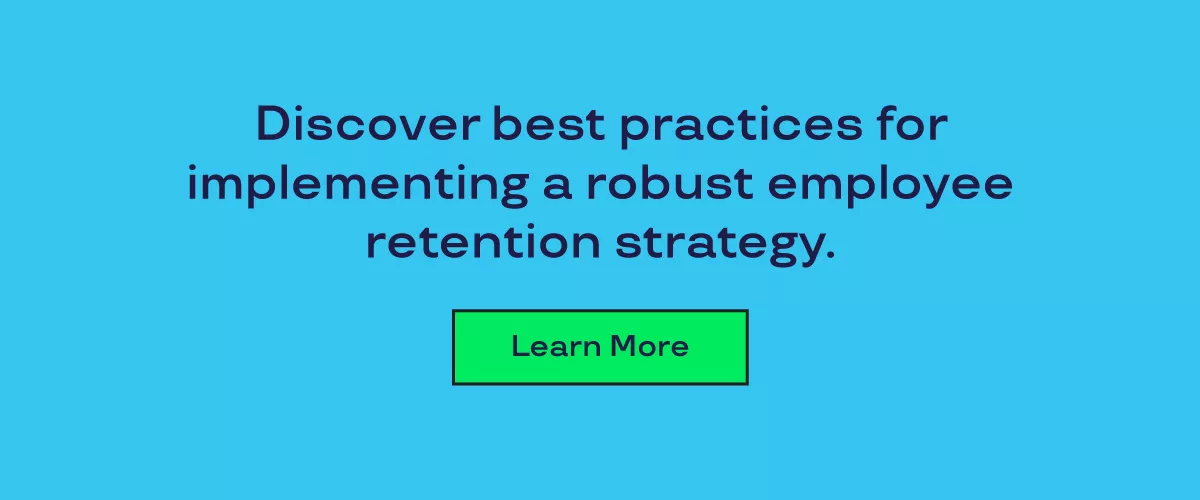
The Key Factors of Employee Retention
December 21, 2023
Replacing an exiting employee is a costly, time-consuming task – especially when it’s an unexpected departure to pursue another opportunity, as opposed to a planned retirement. That’s why employee retention is such a big deal.
In fact, it’s estimated that companies in the U.S. lose more than one trillion dollars annually to voluntary employee turnover, between the hard costs of filling a vacant role and the soft costs of lost knowledge and lowered productivity.
Keeping an employee who may be enticed by the grass being greener elsewhere is often much more effective than trying to find a replacement.
While there’s no one secret to keeping employees motivated and satisfied at work, there are several employee retention factors that together can reduce turnover and drive engagement.
Here are the five main drivers of employee retention that you and your organization should focus on.
Factor #1: Career Development Opportunities
One of the primary factors influencing employee retention is opportunity for career development. No matter where you’re at in life or career, knowing that what you’re currently doing is pushing you toward a brighter future is important.
Employees are more likely to stay with an organization that supports their growth and offers a clear path for advancement. According to a recent workplace survey by LinkedIn Learning, 94% of surveyed employees said that if a company invested in helping them learn and develop new skills, they would stay longer.
Career development can take various forms, such as:
- Formalized training and development programs
- Workshops, seminars and courses
- Mentoring and coaching from leadership or peers
- Opportunities for skill acquisition through job shadowing or rotation
- Cross-training
- Clear promotion and advancement opportunities
- Education reimbursement for job-related degrees or certifications
- Professional memberships and networking
Career development opportunities like these are not only an investment in the employee’s lifelong learning and skill enhancement. They’re also an investment in the company itself.
Factor #2: Work-Life Balance
In the past few years, there has been a seismic shift in expectations around work-life balance and prioritizing wellness in the workplace.
Burnout impacts all industries – in fact, it’s something that 77 percent of employees say they have experienced at least once in their current roles. Employees who maintain a healthy equilibrium between work and personal life are generally happier, less stressed and more productive.
In turn, that balance contributes to a more positive workplace culture and engaged workforce. And when it comes to organizational culture and retention, 33 percent of employees who have good work-life balance say they plan to stay in their current jobs.
Factor #3: Company Culture and Employee Engagement
A positive company culture and high employee engagement go hand-in-hand. Employees want to feel connected to their organization, share its values and have a sense of belonging.
Low employee turnover rate is one of the clearest indicators of a positive culture – people want to stay! On the flip side, a toxic company culture is often the driving force behind a slew of resignations.
How do you develop a great culture that entices employees to stay? The most important elements include:
- Shared values and beliefs
- Emphasis on diversity, equity and inclusion
- Open communication
- Opportunities for feedback
- Recognition and rewards (we’ll get more into this one below!)
Engaged employees are more likely to stay because they feel emotionally invested in the organization's success and have assurance that their leadership is invested in them.
Factor #4: Recognition and Appreciation
Wanting to feel seen and acknowledged for your contributions is human nature – it’s one of the most important ways of knowing you are valued.
Employees who receive regular recognition and praise are more likely to stay with their current employer than those who do not receive such recognition. In fact, employees who feel unappreciated are twice as likely to quit within 12 months.
Recognition in the workplace can come in various forms, from simple expressions of gratitude from managers or peers to formal awards and incentives. Recognizing and celebrating achievements, both big and small, reinforces positive behavior and motivates employees to continue performing at their best.
Factor #5: Flexibility and Adaptability
The ability to adjust to changing circumstances and embrace innovative approaches to work is a must these days. Not only does a more flexible, adaptable approach help employees be more productive, but it also supports a culture of work-life balance.
What does this look like in practice?
Instead of rigid work hours, for example, consider leaning into a more results-oriented work environment. Give employees the flexibility to set their own schedules and work when they are most productive, as long as they meet their goals and deadlines – and then reward employees when those goals are achieved.
Giving employees more flexibility to do their best work can be a powerful tool for attracting and retaining top talent, while also driving results that benefit the organization as a whole.
Employee Satisfaction and Retention Best Practices
Prioritizing these employee retention factors goes a long way in nurturing a workforce of satisfied, engaged and loyal employees who won’t have reason to look elsewhere. But it’s not enough by itself.
Successfully implementing retention and engagement strategies like these requires continually assessing and improving your HR practices, constantly evolving to meet the needs of your people. Want to learn more about how to do so? Read through these transformational insights that will generate positive business outcomes.





